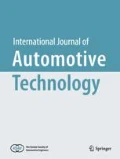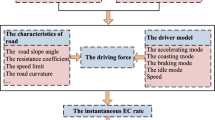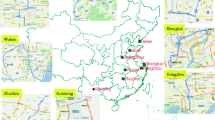Abstract
This paper establishes the simulation model of a city bus on the basis of the EQ6110 bus prototype and its experimental data. According to the actual urban driving cycle, the fuel economy and the traction performance of the EQ6110 city bus have been simulated, and factors such as the driving cycle, the loss of power to engine accessories, the gear-shifting strategy, the fuel shut-off strategy of the engine, etc., which influence on the bus’s fuel economy, are also quantitatively analyzed. Some conclusions are drawn as follows: (1) driving cycles have a great influence on the fuel economy of a city bus; (2) under the typical urban driving cycle of the public bus in China, the engine fuel shut-off strategy can save about 1 to 1.5 percent of the fuel consumption; and (3) the optimized gear-shifting rules can save 6.7 percent of the fuel consumption. Experimental results verify that the fuel economy for the EQ6110 public bus is improved by 7.2 pecent over the actual Wuhan urban driving cycle of the current public bus in China.
Similar content being viewed by others
References
Feng, A., Barth, M. and Scora, G. (1997). Impacts of driving cycles on electric and hybrid electric vehicle performance [C]. SAE Paper No. 972646.
GB/T12543-1990. (1990). Test Method of Acceleration Performance for Commercial Vehicle. National Standard of Peoples Republic of China.
Guo, K. H. and Ren, L. (1999). A unified semi-empirical tire model with higher accuracy and less parameters [A]. SAE Paper No. 1999-01-0785.
Markel, T., Broker, A. and Hendricks, T. (2002). ADVISOR: Systems analysis tool for advanced vehicle modeling. J. Power Source, 4801.
Parten, M. and Maxwell, T. (2001). Advanced gear-shifting and clutching strategy for a parallel hybrid vehicle. Conf. Record of the Annual Conf. IEEE Vehicular Technology Conf. 4,54ND, 2221–2224.
Theory Manual (2004). SoftwareDisc∖AVLCruise∖v3.0∖manuals∖en_US_Letter∖Theory.pdf.
Wang, B. H. (2008). Optimal and Experimental Investigation to Control Strategy of Hybrid Electric Bus [D]. Dissertation of Ph. D.. Shanghai Jiaotong University. China.
Wu, Z. J., Zhao, H. F. and Qin, D. T. (2005). Simulation and analysis of vehicle power train based on cruise [J]. J. Chongqing University. Natural Science Edition 18,11, 8–11.
Yu, Z. S. (2006). Vehicle Theory. China Machine Press. 4th Edn. China.
Zhang, J. Z., Lu, Q. C. and Wang, L. F. (2000). A study on the impacts of driving cycles on vehicle energy economy [J]. Automotive Engineering ([in Chinese]) 22,5, 320–323.
Author information
Authors and Affiliations
Corresponding author
Rights and permissions
About this article
Cite this article
Wang, B.H., Luo, Y.G. & Zhang, J.W. Simulation of city bus performance based on actual urban driving cycle in China. Int.J Automot. Technol. 9, 501–507 (2008). https://doi.org/10.1007/s12239-008-0060-3
Received:
Revised:
Published:
Issue Date:
DOI: https://doi.org/10.1007/s12239-008-0060-3




